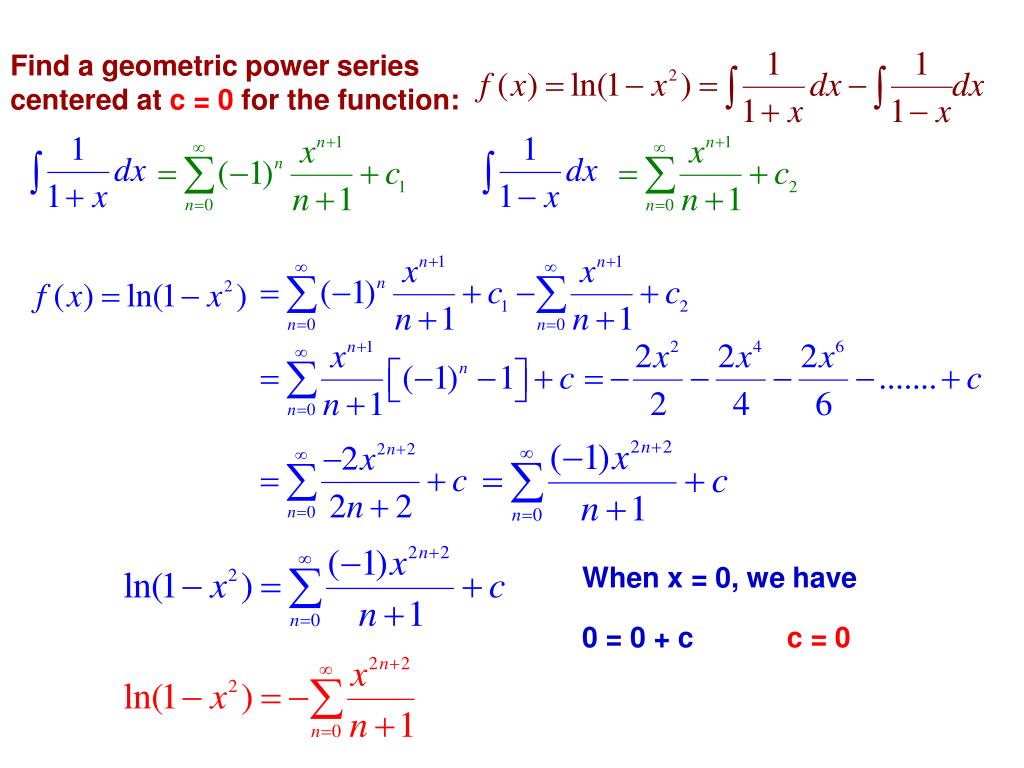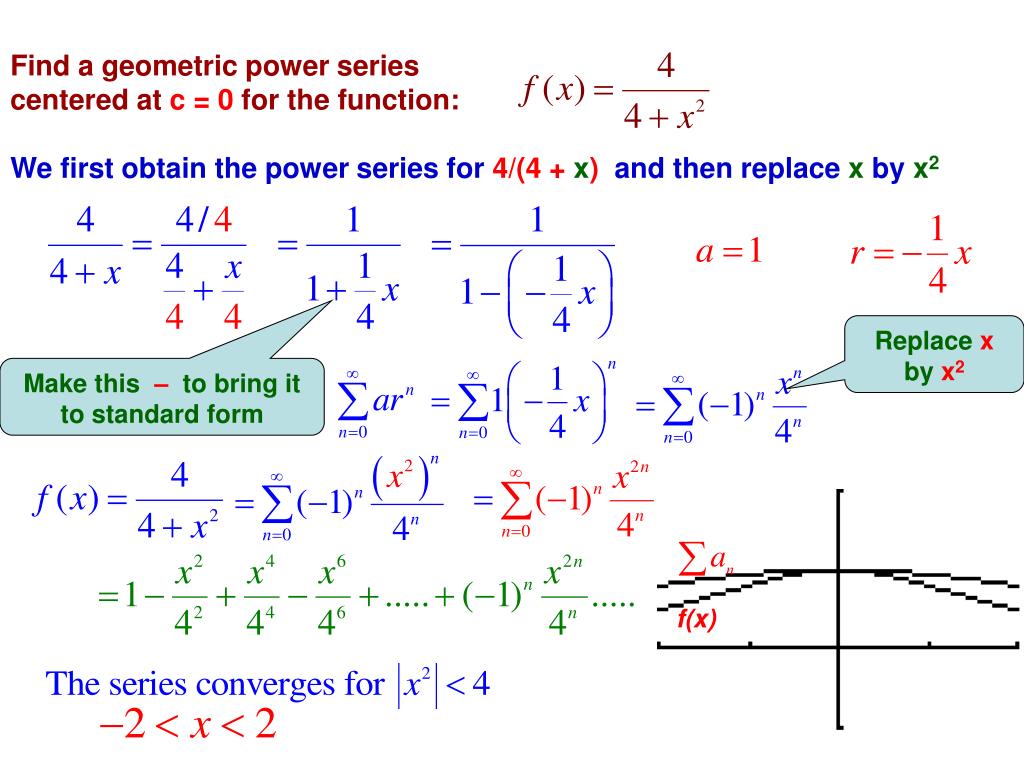Can the intricate world of functions truly be unveiled, their secrets laid bare through the seemingly simple elegance of infinite polynomials? The answer, remarkably, is yes power series provide a potent lens through which to understand and manipulate a vast array of mathematical expressions, offering a bridge between the familiar realm of polynomials and the complexities of higher-level functions.
The concept of representing functions as power series is a cornerstone of calculus and analysis, providing a powerful tool for understanding and manipulating complex mathematical expressions. But what exactly are power series, and why are they so important? At their core, power series offer a way to express functions as infinite sums of terms involving powers of a variable, typically denoted as 'x'. This seemingly abstract construct, however, unlocks a treasure trove of possibilities.
A power series, at its heart, is an infinite polynomial. The general form of a power series centered at a point 'a' is expressed as: $$\sum_{n=0}^{\infty} c_n (x-a)^n = c_0 + c_1(x-a) + c_2(x-a)^2 + c_3(x-a)^3 + ...$$ where the coefficients ($c_n$) are constants and 'x' is the variable. When 'a' is zero, we have a power series centered at zero, or a Maclaurin series.
- Calculate The Mean Formulas Examples Types Learn Now
- Xxxtentacion Real Name Age Life Story Complete Guide
The utility of power series extends far beyond mere symbolic manipulation. By expressing functions as infinite polynomials, we can leverage the well-understood properties of polynomials to analyze and approximate functions that might otherwise be difficult to work with. Since calculus operations (differentiation and integration) are straightforward with polynomials, we can perform the same operations on power series representations, opening doors to solving complex problems.
One of the key aspects of working with power series is understanding their convergence. Not every value of 'x' will result in a convergent power series; for some values, the series will diverge, leading to nonsensical results. The interval of convergence defines the range of 'x' values for which the power series converges to a finite value. The radius of convergence is a measure of the size of this interval, indicating how far from the center 'a' the power series is valid.
The process of finding the interval and radius of convergence involves applying tests like the ratio test or the root test, which examine the behavior of the series as 'n' (the index of summation) approaches infinity. The result identifies the range of 'x' values where the series converges. Within this interval, the power series can accurately represent the original function.
- Unveiling Milana Vayntrub Facts Leaks Atts Lily
- Mary Jo Campbell The Matriarch Of The Kardashianjenner Family
Consider, for instance, the geometric series: $$\frac{1}{1-x} = 1 + x + x^2 + x^3 + ... = \sum_{n=0}^{\infty} x^n, \quad |x| < 1$$ This simple series, valid for |x| < 1, provides a foundational representation for a commonly encountered function. It illustrates how an algebraic expression can be transformed into an infinite polynomial representation.
From this basic representation, we can derive power series representations for related functions through techniques like substitution, differentiation, and integration. For example, by substituting '$x^2$' for '$x$' in the geometric series, we obtain the power series representation of $$\frac{1}{1-x^2} = 1 + x^2 + x^4 + x^6 + ... = \sum_{n=0}^{\infty} x^{2n}, \quad |x| < 1$$
Differentiation and integration open even more avenues. If we know the power series representation of a function, we can differentiate term-by-term to find the power series representation of its derivative. Similarly, we can integrate term-by-term to find the power series representation of its antiderivative. This is a crucial tool, connecting the calculus operations with the functions power series representation.
Consider also, the functions sinhx and coshx :
$$sinhx = \sum_{n=0}^{\infty} \frac{x^{2n+1}}{(2n+1)!} = x + \frac{x^3}{3!} + \frac{x^5}{5!} + ... $$
$$coshx = \sum_{n=0}^{\infty} \frac{x^{2n}}{(2n)!} = 1 + \frac{x^2}{2!} + \frac{x^4}{4!} + ... $$
These examples reveal the power and versatility of power series representations. Power series can be used to approximate a function, evaluate it, compute derivatives and integrals of functions that might not be easy to compute directly. In computer science, power series are essential for numerical analysis and solving differential equations. They also allow calculators and computers to evaluate functions.
The methods used in deriving power series representations are broad. They include manipulation of known series, using algebraic techniques such as substitution, and also relying on calculus, for instance, by differentiation and integration. Taylor and Maclaurin series are key concepts to generating new representations.
To illustrate further, lets consider the function $$\frac{x}{1+x^2}$$ . We can find its power series representation by using a substitution on the geometric series.By replacing '$x$' with '$-x^2$' in the geometric series formula, we have:$$\frac{1}{1-(-x^2)} = 1 + (-x^2) + (-x^2)^2 + (-x^2)^3 + ... $$This simplifies to:$$\frac{1}{1+x^2} = 1 - x^2 + x^4 - x^6 + ... $$Multiplying both sides by '$x$' gives us the power series for the target function:$$\frac{x}{1+x^2} = x - x^3 + x^5 - x^7 + ... = \sum_{n=0}^{\infty} (-1)^n x^{2n+1}$$The interval of convergence remains the same as the original geometric series when it is properly manipulated, so the power series is valid for $\lvert x \rvert < 1 $. The radius of convergence is 1.
The application of power series spans across many fields and is a crucial tool for mathematicians and scientists. For example, in physics, power series are used to solve differential equations that describe the behavior of systems, such as the motion of a pendulum or the flow of heat. In computer science, power series are used in numerical methods for approximating solutions to equations and in developing algorithms for evaluating functions.
The power series representations give us ways to evaluate functions on calculators and computers. The process involves the following steps. Begin with the geometric series formula:$$\frac{1}{1-x} = 1 + x + x^2 + x^3 + ... = \sum_{n=0}^{\infty} x^n, \quad |x| < 1$$This is a foundational representation for f(x).
The power series $\displaystyle\sum_{n=0}^\infty c_n x^n$ can be thought of as a function of $x$ whose domain is the interval of convergence. Conversely, many functions can be expressed as power series, and we will be learning various ways to do this. Now we know that some functions can be expressed as power series, which look like infinite polynomials. Since calculus, that is, computation of derivatives and antiderivatives, is easy for polynomials, the obvious question is whether the same is true for infinite series.
Being able to do this allows us to find power series representations for certain functions by using power series representations of other functions. For example, since we know the power series representation for $\displaystyle f(x)=\frac{1}{1-x}$, we can find power series representations for related functions, such as $y=\dfrac{3x}{1-x^2}$.
In summary, power series representations are an invaluable tool in mathematics and the sciences. They allow us to represent functions in a way that facilitates calculations and analysis that would otherwise be impossible. By expressing functions as infinite polynomials, we can leverage the tools of calculus and algebra to unlock a deeper understanding of their behavior and solve a wide range of problems. The exploration of power series continues, revealing their versatility and fundamental importance in the landscape of modern mathematics.
Key Functions and Their Power Series Representations
Below is a table with common functions, their power series, and their domains of convergence:
| Function f(x) | Power Series Representation | Interval of Convergence |
|---|---|---|
| ex | ∑n=0∞ xn/n! = 1 + x + x2/2! + x3/3! + ... | (-∞, ∞) |
| sin(x) | ∑n=0∞ (-1)n x2n+1/(2n+1)! = x - x3/3! + x5/5! - ... | (-∞, ∞) |
| cos(x) | ∑n=0∞ (-1)n x2n/(2n)! = 1 - x2/2! + x4/4! - ... | (-∞, ∞) |
| ln(1+x) | ∑n=1∞ (-1)n+1 xn/n = x - x2/2 + x3/3 - ... | (-1, 1] |
| 1/(1-x) | ∑n=0∞ xn = 1 + x + x2 + x3 + ... | (-1, 1) |
- Channetta Valentine Nellys Ex Mother Of His Children Details Facts
- Ximena Saenz Nude Leaks Videos See Them Now


